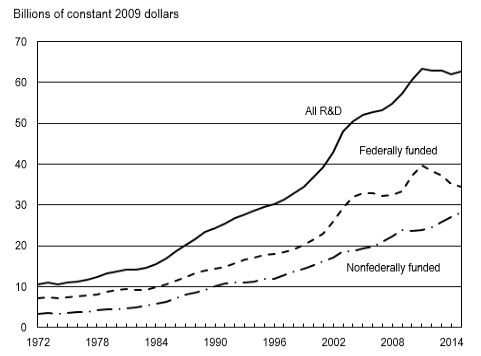 Academic Funding
Academic Funding Government Research Funding Falls for Fourth Year in US

Higher education R&D expenditures, by source of funds: FYs 1972–2015 (Source: National Science Foundation, National Center for Science and Engineering Statistics, Higher Education Research and Development Survey)
The brief builds on data from the Higher Education Research and Development Survey by the National Center for Science and Engineering Statistics within the National Science Foundation. It reports that when adjusted for inflation, federal funding for higher education R&D declined 1.7 percent between FY 2014 and FY 2015 — and has fallen almost 13 percent since its peak in FY 2011. This four-year decline is the longest multiyear measured since the beginning of the annual data collection for this series in FY 1972.
Rhonda Britt, a project officer with the Research and Development Statistics Program of the National Center for Science and Engineering Statistics, prepared the brief.
Despite falling government revenue, U.S. universities reported current dollar R&D expenditures rising 2.2 percent from the year before, to $68.8 billion. These figures are from 906 degree-granting institutions that spent at least $150,000 in R&D in the previous fiscal year. Of that $68 billion, some $38 billion came from the federal government, with $16.8 billion from universities themselves and a little over $4 billion each from non-profits and from business – the first time businesses’ contribution has topped $4 billion. State and smaller governments accounted for $3.8 billion.
Universities reported increases in from three federal agencies in FY 2015 — the Department of Defense, the National Aeronautics and Space Administration, and the Department of Agriculture. By contrast, the largest source of federal research funding, the Department of Health and Human Services, saw expenditures fall for the fourth straight year, from nearly $23 billion in FY 2011 to $20 billion in FY 2015.
All but one of the nonfederal funding sources increased from FY 2014 to FY 2015. The bulk of the increase came from an increase in universities’ own funding, up 5.9 percent to $16.7 billion in FY 2015. This source has increased 32.5 percent between FY 2011 and FY 2015.
Contracted spending has remained roughly flat in the past five years, but money coming from grants and similar arrangements declined 10.1 percent in constant dollars since 2011. In contrast, the amount funded by contracts has held relatively steady during the past 5 years.
Some 64.3 percent of spending of this money is concentrated in three fields: medical sciences ($21.3 billion), biological sciences ($11.7 billion), and engineering ($11.1 billion) (table 3). Medical sciences showed modest growth between FY 2014 and FY 2015, increasing 3.1 percent in current dollars. Biological sciences essentially remained steady and engineering grew less than 1 percent.
Combined, psychology and social science accounted for $3.5 billion of that $68 billion.
From 2014 to 2015, funding for psychology research from all sources rose 3.7 percent to $1.14 billion. Funding for economics rose 7.4 percent, to $430 million, for political science, 7.7 percent to $427 million; for sociology, 4 percent to $505 million; and all other social science disciplines, up 2.6 percent to $853 million. Two fields not listed as social science by the NSF also showed strong growth, albeit from small bases: Research spending in business and management disciplines grew 18.2 percent to $571 million while law research spending grew 17.4 percent, to $175 million.
For the full report, click here.






























































































